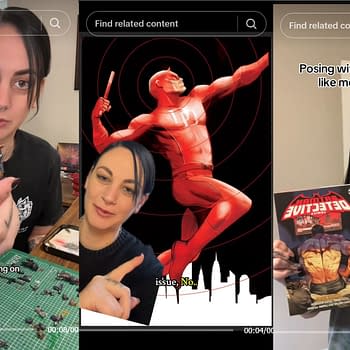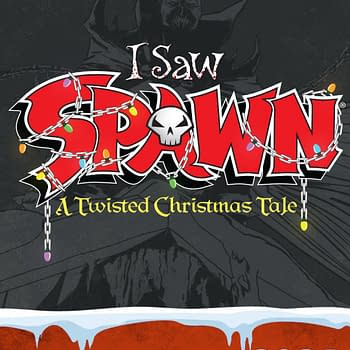Posted in: Comics | Tagged: Comics, dc, dc comics, entertainment, gendercrunching, marvel, tim hanley
Gendercrunching March 2013 – Names And Titles
Tim Hanley writes;
Both publishers were down slightly in March, but Marvel maintained the highest overall percentage of female creators for a ridiculously impressive tenth month in a row. We also take a look at our regular stats from a different angle in our annual roundup.
DC COMICS
DC was down by the tiniest amount in March, continuing a decent run for the publisher in the new year. In March 2013, DC put out 76 new comic books featuring 689 credited creators, 606 men and 83 women. Here are their full stats:
They fell only 0.1% overall, which is completely negligible. By category, cover artists and writers were up, with a nice 2% gain for writers in particular, while everything else was down. Most of these drops were slight, but assistant editors were down more than 5% and pencillers and inkers fell from tiny to miniscule numbers. All together, small drops across the board counteracted a couple of gains, and art continues to be a weak area for DC.
Compared To A Year Ago: DC was at 11% female creators in March 2012, so they're up a full percentage point in the year since.
MARVEL COMICS
Marvel fell more than DC, but nonetheless retained a higher overall percentage, and by a fair amount. In March 2013, Marvel released 73 new comics with 619 credited creators, 538 men and 81 women. Let's look at the numbers:
A drop of 0.5% isn't catastrophic, particularly when Marvel is so high to begin with, but it's certainly sizeable. Only writers and colorists were up, by 1% and 2% respectively. On the creative side, the losses were in the 1-2% range, with letterers remaining steady at 0%, but editors fell more than 3% and assistant editors were down over 5%. Ultimately, the losses were substantial enough to pull down the overall total.
Compared To A Year Ago: In March 2012, Marvel was at 12.7%, so they've gained 0.4% in a year.
A DIFFERENT LOOK AT THE NUMBERS
Every March, we take a look at our usual stats from a different angle. Our regular numbers are based on total credits, so when Jeff Lemire writes 4 books for DC in a month, he gets counted 4 times instead of just once. But, obviously, there's another way to do it. By crediting each creator only once, regardless of how many different books they work on, we can see the stats in a new way.
This new perspective tells us something about both publishers. Last year, we did DC and Marvel separately because they had different outcomes, but this year they're in the same boat. Here are the DC stats, with the lighter "NAMES" columns representing counting each creator only once and the darker "TOTAL" columns representing counting every single credit for each creator:
Most of the numbers are very similar for both approaches, and you can see an even closer similarity in the Marvel numbers:
Given the relative closeness of most of the categories, the fairly large gap for both publishers overall seems odd. DC is off by 2.4% overall while Marvel is off by 3.6%. Generally speaking, across the board at both publishers, the percentages are so close that both men and women worked on different titles in direct proportion to their numbers. For example, at Marvel there were 76 male credits and 6 female credits for writing and 38 different men and 3 different women comprising the credits. Thus, on average, the male and female creators each wrote 2 books each. By category, things seem proportional.
However, overall at DC an average male creator worked on 2 books while an average female creator worked on 2.5. The gap was bigger at Marvel, with men at 2.4 books each and women at 3.4. What this means is that while on an individual basis the average female creator works on more books than the average male creator, both publishers are hiring disproportionately. More different men get work, while the average woman does more work.
I don't think this has much to do with gender bias so much as where women tend to work right now at the Big Two. Going up to our original charts at the top of the page, colorists, editors, and assistant editors are, by far, the biggest categories for female creators. These are jobs that tend to have multiple gigs in a month. Editors work on several titles, while colorists often do a few books. Compare this to penciling and inking, which is male dominated, where a creator is usually on only one book a month. For example, there were 118 inkers at DC in March (2 women) while there were 22 editors (5 women). With men dominating these busier categories, you can see how more different men get hired overall.
This disproportion overall isn't all that troubling, or at least it's not troubling in a new way. We know that the Big Two are poor at hiring female artists. What's interesting is that a year ago, Marvel was nearly directly proportional. DC remains as out of whack overall as they were in 2012, but Marvel was only 0.3% different overall last March. In the year since, their female editorial ranks have grown, which is good, but their female art credits for cover artists, pencillers, and inkers are all down a fair amount. Different women used to get a lot more work in those categories, but not anymore. Marvel is in the midst of a good run overall, but the make up of their total has changed a lot since 2012, perhaps not entirely for the better despite the overall growth.
Anyway, let's close with some fun tidbits from the stats. It's always cool to see who are the busiest creators at the Big Two; there were some names that were surprisingly unfamiliar to me in here:
- There was no clear winner for busiest cover artist at either publisher. David Finch, Gary Frank, Ivan Reis, Jae Lee, and Kenneth Rocafort all had 3 at DC while Mike Deodato, Mike Del Mundo, Salvador Larocca, and Skottie Young all had 4 at Marvel, along with scads of colorists and inkers at the top.
- Geoff Johns and Scott Lobdell wrote 5 books each at DC, while Brian Michael Bendis ruled all with 11 books at Marvel. Holy cats, Bendis.
- Henrik Jonsson penciled 3 books at DC, while Mike Deodato penciled 3 at Marvel. Multiple books were rare, though: Only 10 different pencillers did multiple books at DC, and 14 at Marvel.
- Vicente Cifuentes was the busiest inker at DC with 3 books, while Victor Olbaza did 4 at Marvel.
- DC's busiest colorist was Hi-Fi (aka. Brian Miller) with 6 books while Marvel's Lee Loughridge also worked on 6 books.
- The busiest letterer at DC was Taylor Esposito with 13 credits, but Joe Caramagna won the day with 19 at Marvel.
- Brian Cunningham and Eddie Berganza each edited 9 books for DC, while Tom Brevoort and Lauren Sankovitch had 13 each at Marvel.
- For assistant editors, Rickey Purdin had 12 credits at DC but yet again Marvel had a busier person with Jake Thomas's 16.
Folks at Marvel generally do a lot more work than folks at DC. They run a much smaller operation (253 different creators to DC's 343) but put out just about the same amount of books in March.
Anyway, it's always nice to see that our regular way of doing stats isn't too far off from other ways to look at the numbers. And it's always hilarious to see how many books Bendis writes. The dude needs to leave some books for other people! Seriously, Marvel only put out 73 books in March. Bendis wrote 15% of them. The man is a machine.
To learn more about this statistics project and its methodology click here, and to see the previous stats click here. You can visit Tim at Straitened Circumstances and follow him on Twitter @timhanley01.














